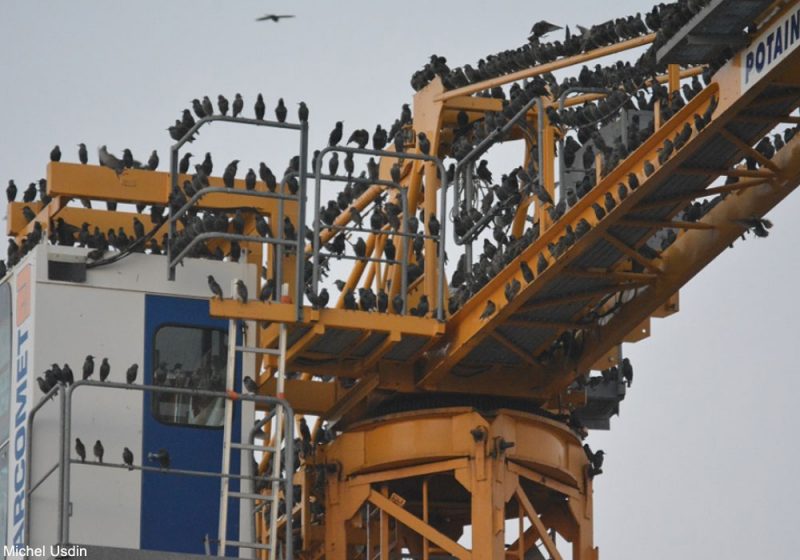Pratique | Débuter
Les pré-dortoirs, dortoirs et post-dortoirs chez les oiseaux

Étourneaux sansonnets (Sturnus vulgaris) en pré-dortoir sur une grue de chantier à Palavas-les-Flots (Hérault) le 10 novembre 2015.
Photographie : Michel Usdin
Introduction
À la fin de l’été, en automne et en hiver, beaucoup d’oiseaux qui vivaient en couple durant la période de reproduction forment des groupes plus ou moins importants : c’est le cas par exemple des canards, des oies, des limicoles et de plusieurs passereaux comme les Corneilles noires, les Étourneaux sansonnets ou les Pinsons du Nord. En fin de journée, ils se regroupent dans des lieux appelés « dortoirs », même s’ils ne servent pas seulement à dormir. Ils peuvent auparavant se rassembler en « pré-dortoirs », et/ou le lendemain matin « post-dortoirs » avant de se disperser pour se nourrir. Après une présentation de ces comportements encore mal connus, nous énumérons leurs fonctions possibles et nous présentons plusieurs exemples.
Abstract
At the end of the summer, in autumn and in winter, many birds that live in pairs during the breeding season form more or less important wandering groups: it is the case for example of the crows, the ducks, the geese, the waders, the cranes or the starlings. By late afternoon, they gather in specific places called roosts. Some species gather before in pre-roosts or after in post-roosts. After a presentation of these poorly understood behaviors, we list their possible functions and describe several examples.
Poursuivez la lecture de cet article, en vous abonnant dès maintenant !
Découvrez les Archives d’Ornithomedia.com
Pour seulement 10,00 €TTC/an (ou 6,00 € les 6 mois)
Profitez de plusieurs centaines d’articles en accès illimité et sans aucun engagement.
Compléments
À lire aussi sur Ornithomedia.com
- Identifier les goélands adultes en hiver dans les dortoirs
- Les dortoirs de Faucons crécerellettes dans le sud de la France
- Un énorme dortoir de Faucons crécerellettes en Albanie
- Les énormes dortoirs de Pinsons du Nord attirent les rapaces
- Un possible dortoir de corneilles au sol !
- Comment les oiseaux supportent-ils les nuits d’hiver et comment les aider ?
- La magie des vols d’étourneaux en partie révélée
- Les vols d’étourneaux fonctionnent comme des systèmes critiques
- Mouvements aériens coordonnés : le cas des étourneaux
- Observer les Grues cendrées dans la réserve nationale de chasse d’Arjuzanx
- La décharge d’Eteignières (France) et les bassins de l’Eau-d’Heure (Belgique)
- Une nidification de l’Épervier d’Europe à Montmartre (Paris)
- Vers une « résurrection » du Pigeon migrateur ?
Sources
- LPO Alsace. Dortoirs hivernaux. http://alsace.lpo.fr/index.php/dortoirs-hivernauxVariability in Parrot
- C. A. Chapman, L. J. Chapman et L. Lefebvre (1989). Flock Size: Possible Functions of Communal Roosts. The Condor. Volume 91. Numéro 4. Pages : 842-847. http://www.jstor.org/stable/1368068?seq=1#page_scan_tab_contents
- Leonard Eiserer Leonard (1984). Communal Roosting in Birds. Bird Behaviour. Volume 5. Numéros 2-3. Pages : 61-80. www.ingentaconnect.com/content/cog/bb/1984/00000005/F0020002/art00001
- Allert I. Bijleveld, Martijn Egas, Jan A. Van Gils et Theunis Piersma (2010). Beyond the information centre hypothesis: communal roosting for information on food, predators, travel companions and mates? Volume 119. Numéro 2. Pages : 277–285. Février. http://repository.ias.ac.in/64196/1/10-pub.pdf
- R.W. Summers (1989). Size and frequency of occurrence of pre-roost gatherings of starlings. Crop Protection. Volume 8. Numéro 6. Pages : 451-454. www.sciencedirect.com/science/article/pii/0261219489900744
- Geir A. Sonerud, Henning Hansen, Christian A. Smedshaug (2002). Individual roosting strategies in a flock-living bird: movement and social cohesion of hooded crows (Corvus corone cornix) from pre-roost gatherings to roost sites. Volume 51. Numéro 4. Pages : 309-318. http://rd.springer.com/article/10.1007/s00265-001-0440-4
- Richard B. Siehl (1981). Observations of a large roost of Common Ravens. The Condor. Numéro 83. Page 78. https://sora.unm.edu/sites/default/files/journals/condor/v083n01/p0078-p0078.pdf
- D. I. Rogers (2003). High-tied roost choice by coastal waders. Wader Study Group Bulletin. Numéro 100. Pages : 73-79. http://obpa-nc.org/DOI-AdminRecord/0054300-0054307.pdf
- Collen M. Handel et Robert E. Gill, Jr. (1992). Roosting Behavior of Premigratory Dunlins (Calidris alpina). The Auk. Volume 109. Numéro 1. Pages : 57-72. www.jstor.org/stable/4088266?seq=1#page_scan_tab_contents
- E. Still, P. Monaghan, E. Bignal (1987), Social structuring at a communal roost of Choughs Pyrrhocorax pyrrhocorax. Ibis. Numéro 129. Pages : 398–403. http://onlinelibrary.wiley.com/doi/10.1111/j.1474-919X.1987.tb03186.x/abstract
- W. J. Peach et J. A. Fowler (1989) Movements of wing-tagged Starlings Sturnus vulgaris from an urban communal roost in winter. Bird Study. Volume 36. Numéro 1. Pages : 16-22. www.tandfonline.com/doi/pdf/10.1080/00063658909476997
- James Brodie (1976). The fligt behaviour of Starlings at a winter roost. British Birds. Volume 69. Pages : 51-60. www.britishbirds.co.uk/pratique/conseils/article_files/V69/V69_N02/V69_N02_P051_060_A014.pdf
- Jeffrey E Moore et Paul V Switzer (1998). Revue canadienne de zoologie. Volume 76. Numéro 3. Pages : 508-512. www.nrcresearchpress.com/doi/abs/10.1139/z97-229#.Vffr4qpdLIU
- R. C. Ydenberg, H. H. TH. Prins et J. Van Djik (1981). The post-roost gatherings of wintering Barnacle Geese: information centres? Ardea. Numéro 71. Pages : 125-131.. www.researchgate.net
- Patrick Smiddy, Chris Cullen et John O’Halloran (2007). Preroosting aggregations in the American crow Corvus brachyrhynchos. Time of roosting of Barn Swallows Hirundo rustica at an Irish reedbed during autumn migration. Ringing & Migration. Volume 23. Numéro 4. www.tandfonline.com/doi/abs/10.1080/03078698.2007.9674369




Aucun commentaire sur ce sujet
Participer à la discussion !